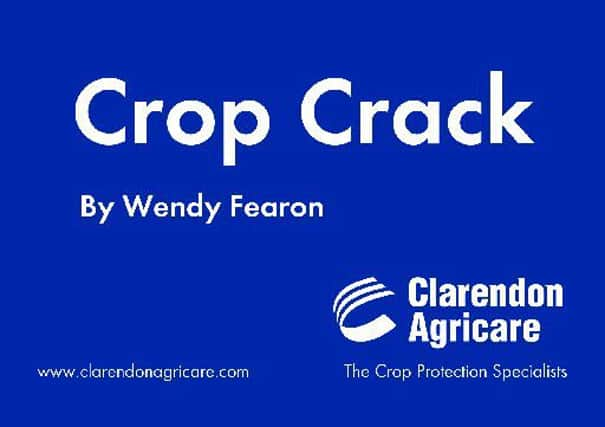Crops and weeds growing rapidly in warm weather


Any straw stiffening required will have to be applied in the next number of days, otherwise this very important window will be missed.
Such growth places the greatest demand on nutrient requirement, and in these circumstances it is inevitable that some will become limiting, therefore leading to deficiency and symptoms appearing.
Advertisement
Advertisement
Even though soil levels may be adequate, many fields are now showing manganese deficiency symptoms and should be treated urgently if not to compromise yield. For most winter barley crops all treatments have been applied and the gates are now closed until desiccation pre-harvest.
Winter Wheat
Despite the poor outlook for grain pricing, a good T3 head spray is critical to protect the potential of all wheat crops. All are still five to six weeks away from the beginning of ripening and harvest some weeks beyond that, therefore the T3 head spray is essential to keep the head clean, maximise grain-fill and maximise yield and quality.
Late ear diseases and especially Ear Blight (caused by various Fusarium species) become the focus, though if the threat or presence of Septoria is the biggest issue, its control must take precedence over Ear Blight. The high triazole loading required for Septoria and Yellow Rust will also provide the best solution for Ear Blight.
Much work has been focused in recent years looking at optimum timing for control of Ear Blight. The optimum timing is very precise - best control is achieved within 48 hours of an infection event, the performance of even the best products dropping off rapidly once this period is extended.
Advertisement
Advertisement
The difficulty is predicting this event, affected by rain splash. The ear is most susceptible to infection at flowering especially during rain, therefore the most practical approach is to treat at early flowering, GS61. This is a change on previous thinking which suggested just after the end of flowering.
The cornerstone for the T3 head spray fungicide remains the triazole despite its decline in Septoria efficacy. Whilst the triazole mixtures of prothio/teb (PROSARO) and epoxi/metcon (BRUTUS) remain the most effective options to give ongoing Septoria protection, tebuconazole is the most effective triazole for Fusarium in particular and an important active in its own right at this time.
The addition of a strobilurin is also essential to maximise the persistence of the triazole, strengthen activity on Yellow Rust, and delay early leaf senescence. Good grain fill is totally dependent on retaining green leaf area for as long as possible, and the addition of the strobilurin extends the retention of green leaf tissue. Last years’ ADHB trials continue to show pyraclostrobin (COMET) to be the highest rated strob for use in wheat, being the strongest performer on Yellow rust and the late ear diseases.
Grass
Weed infestations can impact significantly on the yield and quality of grass for both grazing and cutting. Apart from product choice it is essential to treat weeds when actively growing with the correct water volume. Many weeds emerge at different times in the spring and this can make it difficult to achieve correct timing for all weeds. All grassland herbicides must be used as part of a programmed approach.
Creeping Buttercup,
Dandelion, Ragwort and thistle
Advertisement
Advertisement
Creeping Buttercup and Dandelion are both best controlled by spraying just before or at bud formation. At this stage the plants will have maximum leaf area to absorb the chemical. Dandelions prefer rich fertile soils. Dandelion rosettes can be 3-4cm across, hindering grass growth. Buttercups are encouraged by hard grazing and there is evidence of a link to respiratory disease in livestock.
Product choice depends very much on how much you wish to spend and what the weather is doing as DEPITOX requires 12 hours of dry weather. FOREFRONT T or DEPITOX may be applied to control both buttercup and dandelion. Where clover is important SPRUCE may be applied to control buttercup.
Ragwort is a major problem on Northern Ireland farms, especially in lower fertility situations. Ragwort contains alkaloids which are poisonous to all livestock. It is a biennial plant i.e. it grows from seed the first season to produce a rosette plant, and then the following season it produces a flowering stem, seeds, and then dies. Each plant can produce up to 150,000 seed with a 70% germination rate and seeds can remain dormant in the soil for up to 20 years.
Whilst ragwort is unpalatable when it is green, it becomes extremely palatable once sprayed or ensiled. A single application of weed killer is unlikely to completely eliminate a ragwort infestation and a follow up treatment will be required. When the plant is already in flower treatment is less effective and seeds will already have been set for the following year. FOREFRONT T is the best option for the control of ragwort in grazing ground.
Advertisement
Advertisement
Whilst LUPO used alone gives reasonable control of ragwort, the inclusion of FORTUNE is advised as it significantly improves the performance of this product, improving chemical uptake through the leaf on stubborn weeds such as ragwort and thistle.
Thistles are common on older swards, those low in phosphate and nitrogen but high in potash. These conditions are more typical of beef and sheep farms. As with the Dock, good chemical control requires spraying at the right stage i.e. when the majority of plants are at the full rosette stage, just as stem elongation begins. However because of the wider range of growth stages of a population of thistles at a point in time, not all will be at the right stage at the right time. Topping thistles stops seed spread but not root spread.